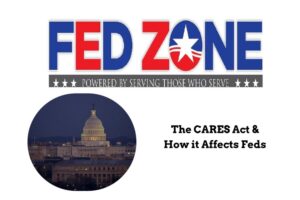Edward Zurndorfer explains how federal employees and annuitants are affected by the recently passed Coronavirus Aid, Relief and Economic Security (CARES) Act
Edward A. Zurndorfer –
On March 27, 2020, President Trump signed into law the Coronavirus Aid, Relief and Economic Security (CARES) Act. Among the important retirement plan features of the CARES legislation is the increase on the limits on qualified retirement plan loans, the loosening of rules on hardship distributions from qualified retirement plans, and the suspension for 2020 of required minimum distributions (RMDs) from qualified retirement plans and the Thrift Savings Plan (TSP) and IRAs (including both traditional and Roth inherited IRAs). The CARES Act also expands the employer tuition reimbursement program. This column discusses how the CARES Act features affect federal employees and annuitants.
Qualified retirement plan loan expansion
The CARE Act doubles the amount that qualified retirement plan (401(k), 403(b) and 457(b) plans and the TSP who have been diagnosed with the coronavirus or affected by economic losses can request in retirement plan loans. The amount has been increased to the lesser of $100,000 (reduced by other outstanding loans) or 100 percent of the account balance. The usual limit is $50,000 reduced by other outstanding loans or 50 percent of the account balance. This rule applies to loans taken within 180 days of the CARES Act enactment, March 27, 2020.
Also, any loan repayments normally due between March 27, 2020 and December 31, 2020 could be suspended for one year.
Though it seems many qualified retirement plans – and the TSP – will likely offer the new expanded retirement plan loan option, these plans do not have to offer the expanded loan option. To offer the expanded retirement plan loan option, the plans (including the TSP) have to amend their plans formally before the new expanded loan option becomes effective.
Qualified retirement plan hardship distribution rules modification
Consistent with previous disaster-related relief, the CARES Act allows distributions made after Dec. 31, 2019 of up to $100,000 from qualified retirement accounts for coronavirus -related purposes. Income attributable to such retirement plan distributions would be subject to federal and state income tax. Retirement plan account owners can pay the federal income taxes due over three years rather than having to pay all of it in the first year following distribution. Also, those retirement plan owners under age 59.5 would be exempt from the IRS’ 10 percent early withdrawal penalty.
Alternatively instead of paying the tax due, a retirement plan owner can recontribute the withdrawn funds back into the retirement plan or to an IRA within three years. This is the case even if the amount the plan owner wants to recontribute exceeds the annual contribution limit. For 2020, the IRA contribution limit is $6,000 ($7,000 for individuals over age 49), and $19,500 ($26,000 for individuals over age 49) to qualified retirement plans.
To qualify for the hardship distribution, the retirement plan owner or his or her spouse or dependent must have been diagnosed with the coronavirus or lost income as a result of a layoff, business closure, reduction in work hours, or the inability to work due to a lack of child care.
The administrators of the qualified retirement plans may rely on an employee’s certification that the retirement plan owner satisfies one or more of the conditions to request a hardship distribution. Note that the coronavirus-related distribution is not considered a qualified retirement plan hardship distribution. This is because the distribution is not subject to the 10 percent premature (early) withdrawal penalty, nor does the 20 percent federal income tax withholding apply. The qualified retirement plan distributions apply only to distributions to eligible individuals between Jan. 1, 2020 and Dec. 31, 2020. Also, the hardship distribution can be repaid (like a loan). Presumably, any taxes paid on the distribution will then be recovered, although it is not clear at this time how recovery of the taxes paid will be done.
Qualified retirement plan and IRA required minimum distribution (RMD) suspension
Individuals who participate in qualified retirement plans like 401(k), 403(b) and 457 plans and the TSP, as well as those individuals who contribute to traditional IRAs, are required to take required minimum distributions (RMDs) upon reaching either age 70.5 (for those born before July 1, 1949) or at age 72 (for those born after June 30, 1949).
Qualified retirement and IRA account holders can always withdraw more than the RMD. But if they withdraw less than the RMD, they could be subject to a 50 percent IRS “excess accumulation” penalty. Under the CARES Act, all RMDs are suspended for all of 2020.
The one-year suspension of RMDs during 2020 applies to all qualified retirement plans, the TSP, and traditional IRAs that individuals own. The suspension also applies to traditional and Roth inherited IRAs (IRAs that beneficiaries inherited from deceased IRA owners and that the beneficiaries have chosen lifetime distribution based on the beneficiary’s life expectancy).
The suspension of RMDs will help retirees in particular who would otherwise have been forced to compute their RMDs for 2020 on their retirement plan or IRA account balances as of Dec. 31, 2019 (when the stock market was near record levels). To illustrate, suppose a 75-year old federal annuitant had a $500,000 TSP balance as of Dec. 31, 2019. According to the RMD calculation rules, the annuitant would have had to withdraw $500,000/22.9 or approximately $22,000 in order to satisfy the 2020 RMD. With the stock market down about 20 percent so far in 2020, the TSP account would be worth perhaps today approximately $400,000. Without the CARE Act enactments, the annuitant’s having to withdraw $22,000 from an account that is worth $100,000 less would have “added salt to the wound”.
The RMD suspension for 2020 also gives retirement plan and IRA owners who can afford to leave their retirement accounts alone and not withdraw from it a better chance of recovering their investment losses. This is because they will have more retirement dollars working for the in the event of a stock market rebound.
For those retirement plan and IRA owners who already made their 2020 RMDs in January, February or March, there will be provisions in order to rollover and/or recontribute these distributions to a qualified retirement plan or to IRA.
Expansion of employer-provided tuition reimbursement program
While it is not technically a retirement plan provision, we all know the financial impact that student loan debt has on retirement savings. The CARES Act expands the tuition reimbursement program (under Internal Revenue Code Section 127) that allows employers to give their employees tuition reimbursement up to $5,250 tax-free prior to Jan. 1, 2021. Tuition reimbursement is for tuition, fees, books and other supplies. Employer payments can be made directly to the employee, or employer payments consisting of principal and interest can be made directly to an employee’s student loan lender. Many relatively new federal employees are burdened with student loans and this expanded program could allow these employees to contribute more to the TSP during 2020. The expanded program is effective for payments made after the CARES Act effective date of March 27, 2020.

Edward A. Zurndorfer is a CERTIFIED FINANCIAL PLANNER™ professional, Chartered Life Underwriter, Chartered Financial Consultant, Chartered Federal Employee Benefits Consultant, Certified Employees Benefits Specialist and IRS Enrolled Agent in Silver Spring, MD. Tax planning, Federal employee benefits, retirement and insurance consulting services offered through EZ Accounting and Financial Services, and EZ Federal Benefits Seminars, located at 833 Bromley Street – Suite A, Silver Spring, MD 20902-3019 and telephone number 301-681-1652. Raymond James is not affiliated with and does not endorse the opinions or services of Edward A. Zurndorfer or EZ Accounting and Financial Services. The information has been obtained from sources considered to be reliable, but we do not guarantee that the foregoing material is accurate or complete. While we are familiar with the tax provisions of the issues presented herein, as Financial Advisors of RJFS, we are not qualified to render advice on tax or legal matters. You should discuss tax or legal matters with the appropriate professional.
